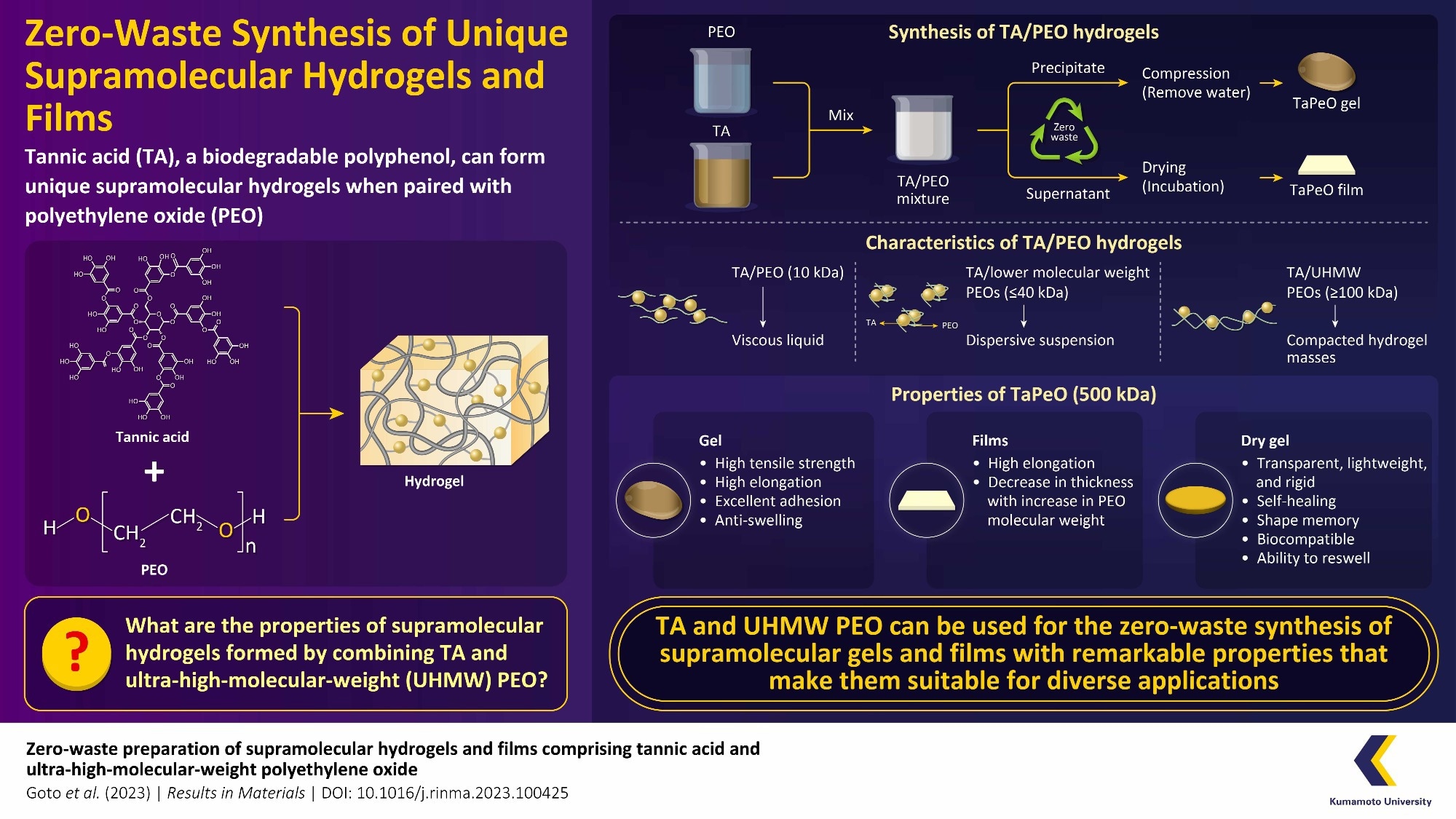Japanese researchers have harnessed the potential of tannic acid and ultra-high molecular weight polyethylene oxide to create robust and intelligent supramolecular gels through an environmentally friendly, zero-waste process.

A blend of UHMW PEO and TA results in the formation of a dense, highly stretchable hydrogel, known as TaPeO Gel. These remarkable gels exhibit exceptional elongation, adhesive properties, and minimal swelling properties. Image Credit: Kumamoto University
These gels showcase remarkable properties, including high stretchability, strong adhesion, resistance to swelling, shape memory, self-healing capabilities, and biocompatibility. Moving forward, these groundbreaking zero-waste gels hold great promise for advanced medical materials, contributing to a sustainable approach in the field of material science.
Recent advancements in the field of chemistry have enabled the economical production of supramolecular materials endowed with advanced properties.
As a result of their special properties, like toughness, self-healing, elasticity, shape memory, and biodegradability, these materials identify diverse applications as advanced materials in several fields.
However, their fabrication frequently includes tedious and complicated processes, organic solvents, and waste production, thereby leading to low yields and high synthesis charges.
One option is to make use of tannic acid (TA), a biodegradable polyphenol that could develop special supermolecules by strongly bonding with other molecules. It is a safe, inexpensive, and environmentally sustainable material together with several applications, like those in the pharmaceutical industry.
In the past few years, TA has been utilized for the synthesis of supramolecular gels utilizing several kinds of polymers, such as macromolecules like polyethylene oxide (PEO). But while such studies have used comparatively low-molecular-weight PEO for making TA gels, ultra-high-molecular-weight (UHMW) PEO has been utilized less commonly.
Taking a source of inspiration from these studies and the potential of TA to develop a viscous glue-like liquid by mixing it in water with PEG, a research group headed by Associate Professor Taishi Higashi and graduate student Yuika Goto from the Graduate School of Pharmaceutical Sciences, Kumamoto University, hoped to come up with hydrogels consisting of PEO and TA.
Their experiments have disclosed the fact that when TA and UHMW PEO are mixed collectively in water, a highly stretchable gel, referred to as “TaPeO gel,” has been formed through a zero-waste process. This study was published in the journal Results in Materials in September 2023.
We started by dissolving TA in water, and then PEO solutions with different molecular weights were mixed with TA at specific ratios to create TA/PEO gels. Following this, we used UHMW PEO with a molecular weight of 500 kDa to create TaPeO Gels. They were obtained by mixing TA and PEO solutions at a ratio of 1:2 (v/v) and compressing the precipitated gel,
Taishi Higashi, Associate Professor, Kumamoto University
The gel, known as "TaPeO Gel" in reference to the TA family, displayed impressive mechanical characteristics. It exhibited remarkable stretching capability, achieving a maximum elongation of over 1,000% or more. The gel also demonstrated excellent adhesion properties, as evidenced by its ability to reattach when its cut surfaces were touched.
The maximum tensile strength and elongation of the reattached gel were comparable to those of the original gel after adhesion. Additionally, it maintained a water content of approximately 20% and exhibited low swelling ratios, ranging from 105% to 107%.
Interestingly, the mechanical properties of TaPeO Gels varied with the molecular weight of PEO, with longer PEO chains leading to higher maximum tensile strengths.
Additionally, the research group prepared dry TaPeO Gel by drying the wet gel at 40 °C for around eight days. They noted that upon drying, TaPeO Gel converted into a lightweight, transparent, plastic-like rigid material with self-healing properties.
Also, they possess shape memory ability, referring to the gel’s potential to return to its original shape upon immersion in hot water following deformation. The mechanical properties of dry TaPeO Gel were impacted by PEO molecular weight, having higher molecular weights as a result of the higher three-point bending flexural strengths.
Following the immersion in water, the reswollen dry TaPeO Gel displayed mechanical properties similar to those of the wet TaPeO Gel, denoting reversibility of gel properties.
To assess their biocompatibility, human cervical cancer cells were exposed to the TaPeO Gel. Remarkably, these cells exhibited nearly 100% viability, indicating that the synthesized gel had low cytotoxicity and displayed excellent biocompatibility.
Furthermore, during the preparation of the gel, the research group confronted a surplus liquid byproduct. Rather than throwing it, they selected to dry the supernatant of the TA/PEO mixture.
The consecutive TaPeO films, although initially brittle, displayed surplus elongation (over 1,500%) following reabsorbing moisture, which was far from the measurement scope of the testing machine that was utilized in this study.
The thickness of such films reduced with increasing PEO molecular weight, as higher molecular weight PEO resulted in highly efficient entanglement with TA and lower concentrations in the supernatant.
These findings suggest that supramolecular films with high elongation can be prepared from the supernatant of TA/PEO mixtures, potentially offering zero-waste production of gels and films.
Taishi Higashi, Associate Professor, Kumamoto University
In conclusion, this research offers significant insights into the creation of novel supramolecular functional materials using TA and UHMW PEO. These materials exhibit outstanding properties and have the potential for numerous environmentally friendly applications. Furthermore, the zero-waste production process aligns perfectly with the goal of environmental sustainability, making these materials highly attractive for future use.
Journal Reference
Goto, Y., et al. (2023) Zero-waste preparation of supramolecular hydrogels and films comprising tannic acid and ultra-high-molecular-weight polyethylene oxide. Results in Materials. doi.org/10.1016/j.rinma.2023.100425.